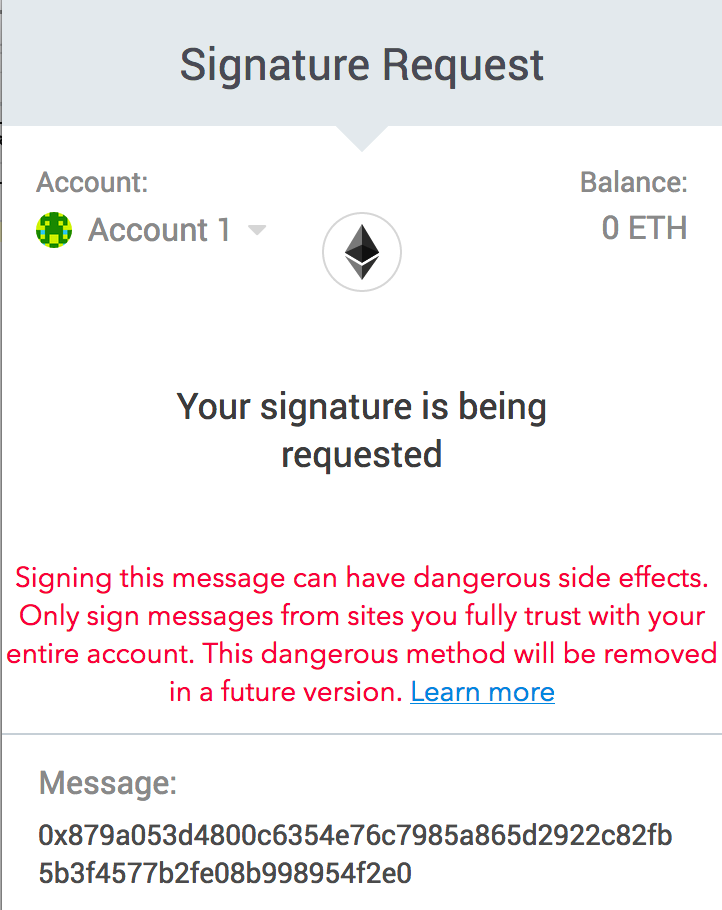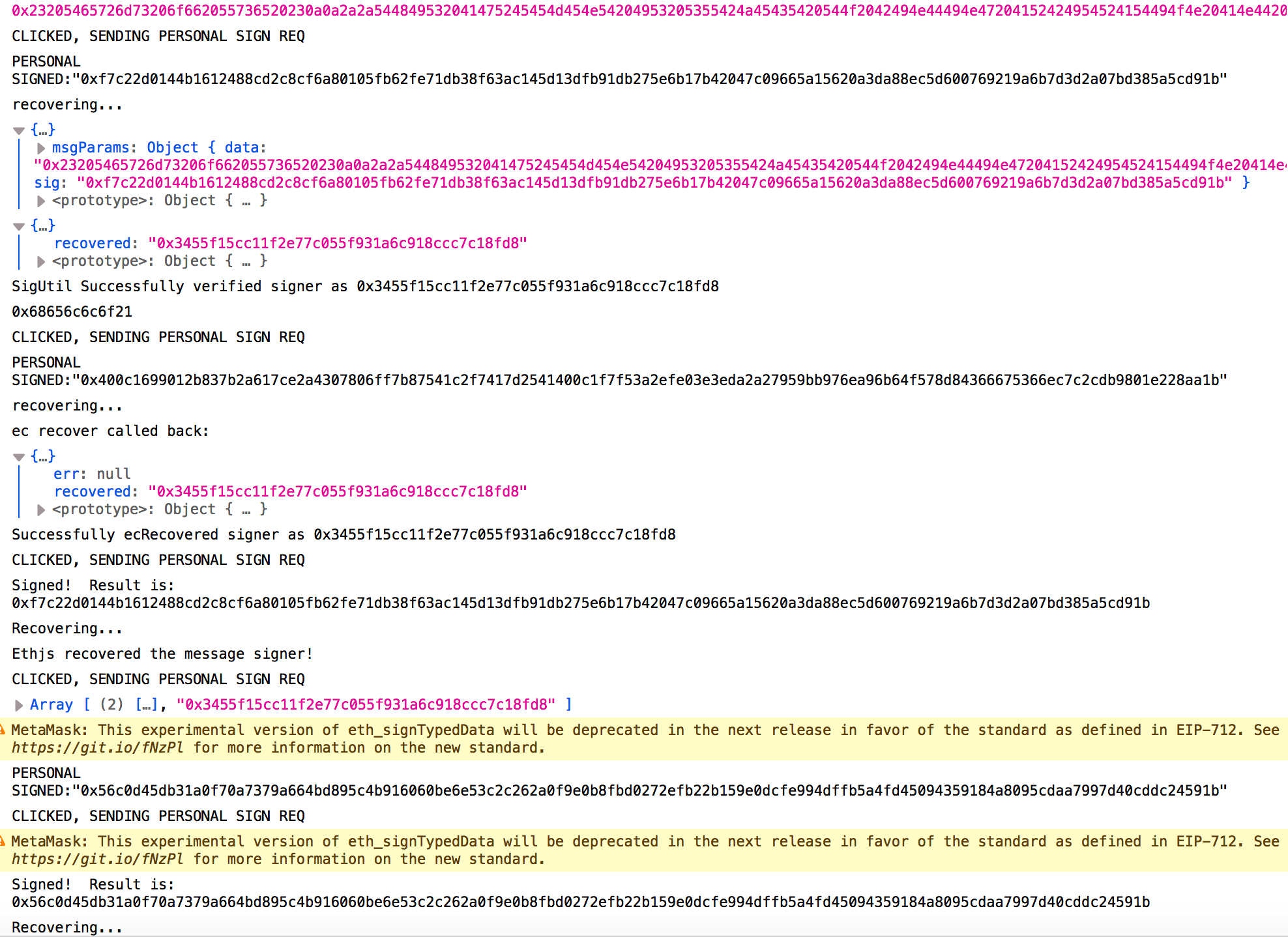https://consensys.zendesk.com/hc/en-us/articles/360004427792-Signature-Request-Warnings-eth-sign
MetaMask helps you manage your Ethereum private keys. As you probably know, you can use these keys to sign transactions that send Ether or ERC20 tokens from one account to another. But you can also use these keys to sign data presented to you by an application. This is powerful: signing data can prove ownership of your account and act as a form of authentication, user consent, or messaging.
metamask帮助我们管理以太坊私钥,我们可以使用这些key去对从一个账户到另一个账户之间的ether和ERC20 tokens交易进行签名。除此之外你还可以使用它来在应用中签署数据来代表你的身份。这是十分有用的,签署数据能够帮助我们证明我们对账户的拥有权或充当身份验证、用户同意或消息传递的形式
As Ethereum has evolved, the mechanics of asking users to sign data have evolved as well. For usability's sake, the community is trying to make data as clear and readable as possible when presented for signing. If an application asks a user to sign a Terms of Service with their private key, the user should be able to understand the content of what they're signing and trust its accuracy.
随着Ethereum的发展,要求用户签署数据的机制也在不断发展。出于可用性的考虑,社区正在努力使数据在提供签名时尽可能清晰和可读。如果应用程序要求用户用私钥签署服务条款,用户应该能够理解他们所签署的内容并相信其准确性。
For some older signing methods, this is not technically possible. When MetaMask encounters an application that asks for a signature on data in a format that's not human readable, we warn our users to sign only if they fully trust the application they are interacting with. In these cases, the balance of your wallet is at stake: it's possible for a malicious actor to encode a real transaction involving Eth or tokens inside the data, ask for your signature, and submit the transaction to the blockchain as if you had signed the transaction yourself.
对于一些较老的签名方法,这在技术上是不可能的。当MetaMask遇到要求对数据进行签名的应用程序时,该应用程序的格式不是人类可读的,我们警告用户只有在完全信任与之交互的应用程序时才签名。在这种情况下,你钱包的余额就岌岌可危了:恶意的参与者可能会对数据中涉及Eth或token的真实交易进行编码,请求您的签名,并将交易提交给区块链,就好像您自己签署了交易一样。

上图这种就是一种很老旧的签名方法,用户并不知道它签署的信息到底是什么
Some applications still rely on these older methods to interact with users, so we continue to support this type of signing functionality in our extension with a significant warning. In the long term we hope the Ethereum community will stop using these dangerous signing methods in favor of newer & safer alternatives.
有些应用程序仍然依赖这些较老的方法与用户交互,因此我们在扩展中继续支持这种签名功能,并发出了重要警告。从长远来看,我们希望Ethereum社区将停止使用这些危险的签约方式,支持更新和更安全的替代方案。

上图就是一种比较新的方法,在这里可以看见用户签署的信息
If you'd like to see how different signing methods interact with the MetaMask extension, check out these signing examples.
如果您想了解不同的签名方法如何与MetaMask扩展交互,请查看写在下面的这个实例中的这些方法:
有一个实现的例子:signing examples.
页面实现为:

这里面实现的代码都写在了bundle.js,从6506行可见对web3签署的API的调用,好好看看,了解人家是怎么实现的
后面学习之后发现实现代码是index.js,bundle.js是使用browserify将index.js转换成了浏览器能调用的格式的代码
var ethUtil = require('ethereumjs-util') var sigUtil = require('eth-sig-util') var Eth = require('ethjs') window.Eth = Eth var fs = require('fs') var terms = fs.readFileSync(__dirname + '/terms.txt').toString() ethSignButton.addEventListener('click', function(event) { event.preventDefault() //阻止元素发生默认的行为(例如,当点击提交按钮时阻止对表单的提交) var msg = '0x879a053d4800c6354e76c7985a865d2922c82fb5b3f4577b2fe08b998954f2e0' var from = web3.eth.accounts[0] web3.eth.sign(from, msg, function (err, result) { if (err) return console.error(err) console.log('SIGNED:' + result) }) }) personalSignButton.addEventListener('click', function(event) { event.preventDefault() var text = terms var msg = ethUtil.bufferToHex(new Buffer(text, 'utf8')) // var msg = '0x1' // hexEncode(text) console.log(msg) var from = web3.eth.accounts[0] /* web3.personal.sign not yet implemented!!! * We're going to have to assemble the tx manually! * This is what it would probably look like, though: web3.personal.sign(msg, from) function (err, result) { if (err) return console.error(err) console.log('PERSONAL SIGNED:' + result) }) */ console.log('CLICKED, SENDING PERSONAL SIGN REQ') var params = [msg, from] var method = 'personal_sign' web3.currentProvider.sendAsync({ method, params, from, }, function (err, result) { if (err) return console.error(err) if (result.error) return console.error(result.error) console.log('PERSONAL SIGNED:' + JSON.stringify(result.result)) console.log('recovering...') const msgParams = { data: msg } msgParams.sig = result.result console.dir({ msgParams }) const recovered = sigUtil.recoverPersonalSignature(msgParams) console.dir({ recovered }) if (recovered === from ) { console.log('SigUtil Successfully verified signer as ' + from) } else { console.dir(recovered) console.log('SigUtil Failed to verify signer when comparing ' + recovered.result + ' to ' + from) console.log('Failed, comparing %s to %s', recovered, from) } /* method = 'personal_ecRecover' var params = [msg, result.result] web3.currentProvider.sendAsync({ method, params, from, }, function (err, recovered) { console.dir({ err, recovered }) if (err) return console.error(err) if (result.error) return console.error(result.error) if (result.result === from ) { console.log('Successfully verified signer as ' + from) } else { console.log('Failed to verify signer when comparing ' + result.result + ' to ' + from) } }) */ }) }) personalRecoverTest.addEventListener('click', function(event) { event.preventDefault() var text = 'hello!' var msg = ethUtil.bufferToHex(new Buffer(text, 'utf8')) // var msg = '0x1' // hexEncode(text) console.log(msg) var from = web3.eth.accounts[0] /* web3.personal.sign not yet implemented!!! * We're going to have to assemble the tx manually! * This is what it would probably look like, though: web3.personal.sign(msg, from) function (err, result) { if (err) return console.error(err) console.log('PERSONAL SIGNED:' + result) }) */ console.log('CLICKED, SENDING PERSONAL SIGN REQ') var params = [msg, from] var method = 'personal_sign' web3.currentProvider.sendAsync({ method, params, from, }, function (err, result) { if (err) return console.error(err) if (result.error) return console.error(result.error) console.log('PERSONAL SIGNED:' + JSON.stringify(result.result)) console.log('recovering...') const msgParams = { data: msg } msgParams.sig = result.result method = 'personal_ecRecover' var params = [msg, result.result] web3.currentProvider.sendAsync({ method, params, from, }, function (err, result) { var recovered = result.result console.log('ec recover called back:') console.dir({ err, recovered }) if (err) return console.error(err) if (result.error) return console.error(result.error) if (recovered === from ) { console.log('Successfully ecRecovered signer as ' + from) } else { console.log('Failed to verify signer when comparing ' + result + ' to ' + from) } }) }) }) ethjsPersonalSignButton.addEventListener('click', function(event) { event.preventDefault() var text = terms var msg = ethUtil.bufferToHex(new Buffer(text, 'utf8')) var from = web3.eth.accounts[0] console.log('CLICKED, SENDING PERSONAL SIGN REQ') var params = [from, msg] // Now with Eth.js var eth = new Eth(web3.currentProvider) eth.personal_sign(msg, from) .then((signed) => { console.log('Signed! Result is: ', signed) console.log('Recovering...') return eth.personal_ecRecover(msg, signed) }) .then((recovered) => { if (recovered === from) { console.log('Ethjs recovered the message signer!') } else { console.log('Ethjs failed to recover the message signer!') console.dir({ recovered }) } }) }) signTypedDataButton.addEventListener('click', function(event) { event.preventDefault() const msgParams = [ { type: 'string', name: 'Message', value: 'Hi, Alice!' }, { type: 'uint32', name: 'A number', value: '1337' } ] var from = web3.eth.accounts[0] /* web3.eth.signTypedData not yet implemented!!! * We're going to have to assemble the tx manually! * This is what it would probably look like, though: web3.eth.signTypedData(msg, from) function (err, result) { if (err) return console.error(err) console.log('PERSONAL SIGNED:' + result) }) */ console.log('CLICKED, SENDING PERSONAL SIGN REQ') var params = [msgParams, from] console.dir(params) var method = 'eth_signTypedData' web3.currentProvider.sendAsync({ method, params, from, }, function (err, result) { if (err) return console.dir(err) if (result.error) { alert(result.error.message) } if (result.error) return console.error(result) console.log('PERSONAL SIGNED:' + JSON.stringify(result.result)) const recovered = sigUtil.recoverTypedSignature({ data: msgParams, sig: result.result }) if (recovered === from ) { alert('Successfully ecRecovered signer as ' + from) } else { alert('Failed to verify signer when comparing ' + result + ' to ' + from) } }) }) ethjsSignTypedDataButton.addEventListener('click', function(event) { event.preventDefault() const msgParams = [ { type: 'string', name: 'Message', value: 'Hi, Alice!' }, { type: 'uint32', name: 'A number', value: '1337' } ] var from = web3.eth.accounts[0] console.log('CLICKED, SENDING PERSONAL SIGN REQ') var params = [msgParams, from] var eth = new Eth(web3.currentProvider) eth.signTypedData(msgParams, from) .then((signed) => { console.log('Signed! Result is: ', signed) console.log('Recovering...') const recovered = sigUtil.recoverTypedSignature({ data: msgParams, sig: signed }) if (recovered === from ) { alert('Successfully ecRecovered signer as ' + from) } else { alert('Failed to verify signer when comparing ' + signed + ' to ' + from) } }) })
在运行的过程中我们能够看见我们进行签名的信息到底是什么
在页面控制器中的返回信息如下图所示:
点击eth_sign,metamask如图:

不能看见签署的信息到底是什么
而另外的几种新的签名方法都能够很详细地看见用户对什么信息进行了签名
